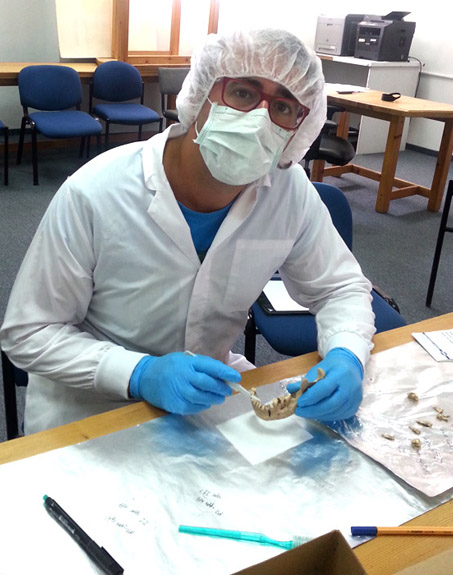Proteins from dental tartar confirm that the global trade in exotic foods reached the Mediterranean almost 4,000 years ago
- Scientific Culture and Innovation Unit
- January 2nd, 2021
Domingo C. Salazar, researcher of excellence of the Valencian Government at the University of Valencia, is one of the signatories of a work published in the PNAS magazine that shows that long-distance trade in exotic species such as turmeric or banana reached the Mediterranean about 3,700 years ago, much earlier than previously believed. The study of ancient proteins preserved in the tartar of human teeth reveals that at the time oriental species and culinary oils were already used.
“Today’s Mediterranean cuisine, including Valencian cuisine, is characterised by being forged based on cultural exchanges, and we now know that this was the case already during the Bronze Age as this study shed light on how globalisation affected cuisine millennia ago Mediterranean”, explains the biomolecular archaeologist Domingo C. Salazar García. The aim of this research was to clarify whether the early globalisation of commercial networks in the Bronze Age also affected food.
The research team has analysed food residues in dental tartar and has found evidence that the inhabitants of the eastern Mediterranean coast already consumed turmeric, bananas and even soybeans during the Bronze Age and the Iron Age. For their analysis, the international team (with researchers from Israel, Germany, the United Kingdom and Spain) examined the remains of 80 people from the excavations of Megiddo and Tell Erani (Israel), sites included in an area considered an exchange route between Egypt, the Mediterranean and Asia 4,000 years ago.
“Exotic spices, fruits and oils from Asia thus reached the Mediterranean several centuries, in some cases even millennia, earlier than previously thought”, says Philip Stockhamer, senior co-author of the study. “This is the earliest direct evidence to date for turmeric, banana, and soy outside of South and East Asia”, concludes Robert C. Power, co-first author of the paper. It is also direct evidence that as early as the second millennium BC. There was a flourishing long-distance trade in exotic fruits, spices, and oils, which is believed to have connected South Asia and the Mediterranean through Mesopotamia or Egypt.
The aim of the research was to know the eating habits of the populations of this area during the Bronze Age by analysing traces of food remains, including proteins and micro-remains of plants in human dental calculus. In this sense, the human mouth is full of bacteria, which continuously petrify and form stones, remaining during the process tiny particles of food trapped and preserved in them, which are what have now allowed the investigation. “We are lucky to find people who did not pay much attention to dental hygiene in the past, which today allows us to study their dental calculus”, explains Domingo C. Salazar.
Paleoproteomics
The research team has used a paleoproteomic method (studying ancient proteins) that they hope can become a standard procedure in archaeology. “Our high-resolution study of ancient proteins and plant remains from human dental calculus is the first of its kind to study the cuisines of the ancient Near East”, says Christina Warinner, senior co-author of the paper.
“Our approach breaks new scientific ground”, explains PhD student and co-first signer Ashley Scott. This is because assigning individual protein residues to specific foods is not an easy task. “Interestingly, we found that allergy-associated proteins appear to be the most stable in the human calculation”, says Scott, a finding that she believes may be due to the thermostability of many allergens. For example, the researchers were able to detect wheat through wheat gluten proteins. The team was then able to independently confirm the presence of wheat using a type of plant micro-remnant known as a phytolith.
The international team for this research is made up of scientists from, in addition to the University of Valencia, the Ludwig Maximilian University of Munich, Harvard University, the Max Planck Institute for the Science of Human History and the University of Haifa.
Trajectory
Domingo C. Salazar (Valencia, 1981) is a biomolecular archaeologist. He is a researcher of Excellence of the Valencian Government in the Department of Prehistory, Archaeology and Ancient History of the University of Valencia. His research focuses on the reconstruction of lifestyles in prehistory and early historical periods. He is especially interested in Neanderthals, the transition to agriculture, and the emergence of complex societies. Its action has focused on analysing human diet, health and migration through biogeochemical (isotopic, proteomic and lipid residue analysis) and microscopic techniques in a variety of human and faunal tissues (bones, teeth, hair, dental stones), as well as ceramic remains.
Article:
Scott AS, Power RC, Altmann-Wendling V, Artzy M, Martin MAS, Eisenmann S, Hagan R, Salazar-Garcia DC, Salmon Y, Yegorov D, Milevski I, Finkelstein I, Stockhammer PW, Warinner C. (2020) “Evidence for long-distance trade in exotic foods and spices from South Asia to the Near East in the 2nd millennium BCE”. Proceedings of the National Academy of Sciences. PNAS first published December 21, 2020. DOI: https://doi.org/10.1073/pnas.2014956117
Photo captions:
1.- Domingo C. Salazar is a biomolecular archaeologist and researcher at the University of Valencia.
2.- 3D reconstruction of Tomb 50 of Megiddo. (c) The Megiddo Expedition.




 Megiddo Excavation,0.jpg)












